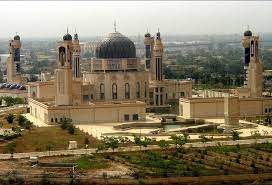The world is a busy place, with politics changing and events happening all the time. However, we make it simple to quickly read all the pertinent data for every country, in addition to flag details and an atlas summary for what kind of general information you are most interested in.
The following basic facts and information are covered in detail in each Country’s Profile:
Maps, geography, Brief history, the current ruler, area, population, capital, and largest cities – Languages-Race and ethnicity – Faith – Rate of literacy and The economy.
Facts & Information about Iraq
Let’s explore everything you need to know about Pakistan. Check out our country profile, full of essential information about Oman’s geography, history, government, economy, population, culture, religion, and languages.
Flag Of Iraq

Map of Iraq

Religions: Muslim (official) 99% (Shia 60%-65%, Sunni 32%-37%), Christian 0.8%, Hindu <.1, Buddhist <.1, Jewish <.1, folk religion <.1, unafilliated .1, other <.1
Note: While there has been voluntary relocation of many Christian families to northern Iraq, recent reporting indicates that the overall Christian population may have dropped by as much as 50% since the fall of the Saddam HUSSEIN regime in 2003, with many fleeing to Syria, Jordan, and Lebanon (2010 est.)
National Holiday: Revolution Day, July 17
Literacy rate: 78.5% (2010 est.)
Economic summary: GDP/PPP (2013 est.): $249.4 billion; per capita $7,100
Real growth rate: 4.2%. Inflation: 2%
Unemployment: 16%
Arable land: 9.19%
Agriculture: wheat, barley, rice, vegetables, dates, cotton; cattle, sheep, poultry. Labor force: 8.9 million; agriculture 21.6%., industry 18.7%, services 59.8%
Industries: petroleum, chemicals, textiles, leather, construction materials, food processing, fertilizer, metal fabrication/processing. Natural resources: petroleum, natural gas, phosphates, sulfur
Exports: $91.99 billion (2013): crude oil (84%), crude materials excluding fuels, food and live animals. Imports: $66.61 billion (2013): food, medicine, manufactures
Major trading partners: U.S., Syria, Turkey, India, China, South Korea, Canada, Spain, Italy (2012).
Communications
Telephones: main lines in use: 1.87 million (2009); mobile cellular: 26.76 million (2009)
Broadcast media: The number of private radio and TV stations has increased rapidly since 2003; government-owned TV and radio stations are operated by the publicly-funded Iraqi Public Broadcasting Service.
Private broadcast media are mostly linked to political, ethnic, or religious groups; satellite TV is available to an estimated 70% of viewers and many of the broadcasters are based abroad; transmissions of multiple international radio broadcasters are accessible (2007).
Internet hosts: 26 (2012). Internet users: 325,900 (2009)
Transportation
Railways: total: 2,370 km (2006)
Highways: total: 59,623 km; paved: 59,623 km (2012)
Waterways: 5,279 km (not all navigable); note: Euphrates River (2,815 km), Tigris River (1,895 km), and Third River (565 km) are principal waterways (2006)
Ports and harbors: Al Basrah, Khawr az Zubayr, Umm Qasr. Airports: 102 (2013)
International disputes: Iraq’s lack of a maritime boundary with Iran prompts jurisdiction disputes beyond the mouth of the Shatt al-Arab in the Persian Gulf; Turkey has expressed concern over the autonomous status of Kurds in Iraq.
Geography
Iraq, a triangle of mountains, desert, and fertile river valley, is bounded on the east by Iran, on the north by Turkey, on the west by Syria and Jordan, and on the south by Saudi Arabia and Kuwait. It is twice the size of Idaho. The country has arid desert land west of the Euphrates, a broad central valley between the Euphrates and the Tigris, and mountains in the northeast.
The dictatorship of Saddam Hussein collapsed on April 9, 2003, after U.S. and British forces invaded the country. Sovereignty was returned to Iraq on June 28, 2004.
History
Because it includes a sizable portion of the alluvial plains of the Tigris and Euphrates rivers, Iraq has been referred to as Mesopotamia—the region between the rivers—since prehistoric times.
This region had a well-developed civilization by 4000 B.C. The region served as the capital of the ancient Babylonian and Assyrian empires at some point after 2000 B.C. Both Alexander (331 B.C.) and Cyrus the Great (538 B.C.) subjugated Mesopotamia. Following an Arab invasion in 637–640, Baghdad was designated as the caliphate’s capital. The Mongols pillaged the nation in 1258, and Turkish and Persian forces competed with it in the 16th, 17th, and 18th centuries.

Leave a Reply